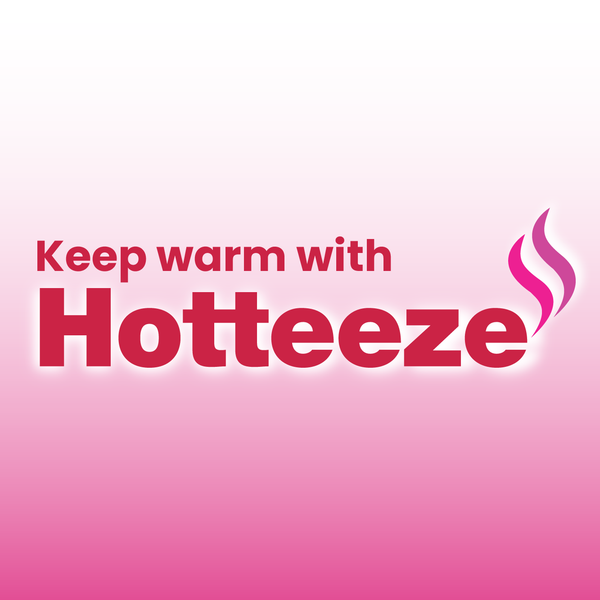Heat Pads in Aged Care

Hotteeze have been used in Australian private and public aged care facilities, hospitals and Physiotherapy clinics since 2005.
People who are not physically mobile can feel cold even on a hot day.
Hotteeze body warmers, hand warmers, and toe warmers can be a cost-effective comfort for the elderly and infirm.
Benefits of Hotteeze
Since wheat bags and hot water bottles have been discontinued due to safety concerns, Hotteeze provide a wonderful solution for people craving the comfort of localised heat because they are;
1. One use only
This limits the risk of cross infection between patients
2. Time-saving
Staff don't have to keep reheating them as they last for up to 16 hours
3. Made in Japan
Hotteeze Heat Pads pass the strictest of quality standards
4. Registered with the TGA
5. Endorsed by the Australian Physiotherapy Association (since 2012)
What to be careful of
Do not apply to people who are too frail to recognise how hot the heat pad feels. There are risks of low temperature burns if you keep applying to the same place day after day. For some elderly, their skin is thin so care must be taken. Make sure they move the pad to a different place a few times a day.
Try sticking a Hotteeze on a pillow and covering with a pillow case to help protect frail skin. NEVER apply directly to skin. Hotteeze are designed to create moist heat and needs a layer of clothes to allow the skin to lightly sweat- ensuring a deeper heat.
For a Safety Data sheet email custserv@hotteeze.com
Please check out our Aged Care Wholesale FAQ for some quick answers
FOR HOTTEEZE HAND WARMERS WITHOUT ADHESIVE, THEY ARE SAFE TO BE HELD IN HANDS.
Diabetics- can heat pads help? Yes.
Targeted heat therapy, except in the instances of late stages of Diabetes Mellitus and advanced Neuropathy, can be beneficial for Diabetics with infrared saunas and localized heat pads having a positive effect on patients. Heat therapy “is a promising supplemental therapy for elderly (diabetic) amputees) with circulatory disorders.
Elderly diabetics in Japan who underwent infrared dry sauna, heat pack and thermal sheeting full body heat therapy “recovered their ability to walk outside and showed healing of intractable ulcers”. (Jpn J Compr Rehabil Sci Vol5,2014)
Local heat therapy from heat pads (like Hotteeze) can aid in wound healing though global heat treatment is more superior.(Yasemin Turan 2015).
“Heat treatment increases blood flow to the area as a result of inducing vasodilatation, which is thought to contributes to wound healing”.
For patients with no feeling from advanced neuropathy, heat pad usage should be limited to 30 minutes at a time on unaffected areas of the body.
Congestive Heart Failure- heat benefits
Topical Thermal Therapy with heat pads applied to the upper torso of patients with stable heart failure can provide comfort when applied on a routine basis. “Heat is a natural vasodilator. Judicious use of heat in the form of thermal baths, saunas and/or heating pads” can be offered to patients with chronic, stable HF” (Weber, Silver 2007)
In a study at the University of Ottawa Heart Institute, the clinical impact of heat therapy on elderly patients with heart failure netted positive results. “Significant improvements were noted across a wide scope of heart failure‐related parameters in the areas of (1) endothelial function, (2) hemodynamics, (3) cardiac geometry, (4) neurohormonal markers, and (5) quality of life. Of special note, thermal therapy also conveyed a strong antiarrhythmic effect in heart failure patients. The clinical evidence highlights repeatable and compelling data showing that thermal therapy may provide an important and viable adjunct in the treatment of heart failure.” (Mussivand, Alshaer, Haddad 2008)
Other forms of pain
Clinical studies have reported the effective use of heat therapy to reduce pain, anxiety, nausea and heart rate in patients suffering from numerous other chronic health conditions. Examples include gallstones (Kober et al 2003a), abdominal pain from renal colic (Kober et al 2003b), pelvic pain from cystitis, urolithiasis, appendicitis, colitis and rectal trauma (Bertalanffy et al 2006).
References
Akin, M et al, J Reproductive Medicine 2004;49(9):739-745.Akin, M et al, Obstetrics & Gynecology 2001;97(3):343-349.
Aksit R. Warm and cold in treatment. Medical Rehabilitation. In: Oguz H, editor. İstanbul: Nobel Tıp Kitapevi; 1995. pp. 179–198.
Weber,A, Silver M.A “Heat Therapy in the Management of Heart Failure”
Bertalanffy, P et al, J Obstetrics & Gynaecology 2006;113(9):1031-1034.
Dehghan, M & F Farahbod, J Clin Diagn Res 2014;8(9): LC01-LC04.
Diabetes Technol Ther. 2007 Dec; 9(6):535-44.
Japanese Journal of Comprehesive Rehabilitation Science (2014) Volume 5 pg 61
Kent, P, Aust J Phsiother 2006;52(3): 227.
Kim, MY, J Phys Ther Sci 2011;23:797-801.
King, B et al, Physiological Society Annual Conference 2006.
Kober, A et al, Anesthesia and Analgesia 2003a;96(5):1447-1452.
Kober, A et al, J Urology 2003b;170(3):741-744.
Michlovitz, SL, Orthopedics 2002;25:S1467.
Nadler, SF et al, Spine 2002;27(10):1012-1017.
Petrofsky, J, CL of Sport Med 2017;27(4):329-337.
Petrofsky, J, J Clin Medicine Research 2013;5(6):416-425.
Petrofsky, J, M Laymon & H Lee, Med Sci Monit 2013;19:661-667.
Petrofsky, JS, J Strength Cond Res 2015;29(11):3245-52.
Seto, H, J Orthopaedic Sci 2008;13(3):187-191.
Steiner, D et al, Proceedings of the 19th Annual Scientific Meeting of the American Pain Society 2000;112.
Szymanski, DJ, Strength Cond J 2001;23(4):7-13.
Weingand, KW, Med Sci Sports Exerc 1999;31:S75.
Yasemin Turan, Kevser Bayraktar, Department of Physical Therapy and Rehabilitation,
Yildirim, N, MF Ulusory & H Bodur, J Clinical Nursing 2010;19(7-8):1113-1120.
